Geotimes

Untitled Document

Geomedia
Geotimes.org offers
each month's book reviews, list of new books, book ordering information and new
maps.
Check out this month's On
the Web links, your connection to earth science friendly Web sites. The popular
Geomedia feature now available by topic.
Book Reviews:
On the Shelf for the Holidays
Quakes, Shakes and Fakes: The Big One
Maps:
New Maps from the U.S. Geological Survey
On
the Shelf for the Holidays
Every year, Geotimes receives dozens and dozens of books to consider for
reviews. While we run full reviews for a handful of them (for example, The
Big One, reviewed below), we still end up leaving many great books on our
shelves that we regrettably were not able to review. So this holiday season, we’ve
sorted through our collection to offer up some nice gift ideas for the georeader
on your holiday list. Enjoy!
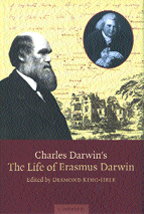 |
Charles Darwin’s The Life of Erasmus
Darwin, edited by Desmond
King-Hele. Cambridge University Press, 2003. ISBN 0 5218 1526 6. Hardcover,
$30.00.
Versions of Charles Darwin’s book about his grandfather, Erasmus,
have been published since it was first written in 1879, but Desmond King-Hele’s
edited edition is the first unabridged version and includes many passages
once cut out by Charles’ daughter. Published in the bicentennial
year of Erasmus Darwin’s death, Charles Darwin’s The Life
of Erasmus Darwin is a short book about one of the most prominent
intellectuals of the 18th century that plays out like a biopic, rather
than a true narrative or biography. It includes private letters and notes
from the family, some of Erasmus’ poetry — he was a doctor,
poet, inventor and astronomer — and anecdotes told by a grandson.
|
Wesley Earl Dunkle: Alaska’s
Flying Miner, by Charles Caldwell Hawley. University Press of Colorado,
2003. ISBN 0 8708 1723 x. Hardcover, $34.95.
The life of Wesley Earl Dunkle is an account of dangerous adventures on
land and in the air. As a manager of mines for such industry moguls as J.P.
Morgan and the Guggenheims, Dunkle brought forth a new age of copper and
coal mining in the highly disputed lands of early 20th century Alaska. Dunkle
went on to earn his pilot’s license and then to develop what would eventually
be Alaska Airlines, all in an effort to aid prospecting an undeniably harsh
region. Charles Caldwell Hawley, an economic geologist for more than 50
years, follows the footprints left behind by Wesley Earl Dunkle: Alaska’s
Flying Miner. |
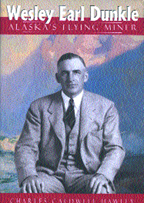
|
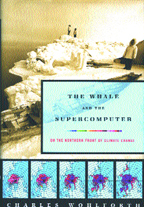
| The Whale and the Supercomputer:
On the Northern Front of Climate Change, by Charles Wohlforth. North
Point Press, 2004. ISBN 0 8654 7659 4. Hardcover, $25.00.
“Climate change isn’t an abstraction in the Far North. It is a reality that
has already altered daily life for Native people who still live largely
off the land and sea,” writes Charles Wohlforth in his new book The Whale
and the Supercomputer. What makes this book fascinating is how Wohlforth
weaves together the science of climate change in Alaska, the anecdotal tales
of Natives experiencing environmental changes firsthand, and the scientists
who come in droves to study climate in the Arctic. This is a good book for
the conservationists and outdoor enthusiasts on your holiday gift list.
|
Better Off: Flipping the Switch
on Technology, by Eric Brende. HarperCollins Publishers, 2004. ISBN
0 0605 7004 0. Hardcover, $24.95.
The only reason Eric Brende has an e-mail address is because his editor
demands it. After graduating from MIT, Brende and his wife set off to join
an obscure band of farmers known as the Minimites, considered primitive
even by Amish standards. Leaving the world of technocrats, cars and electricity
behind, the Brendes set out to determine “what is the least we need to achieve
the most?” The result is an 18-month experiment, described in Better
Off: Flipping the Switch on Technology. The surprising and entertaining
results could shed light on energy conservation, especially in this time
of high oil prices and uncertainty in global oil supply. |
 |
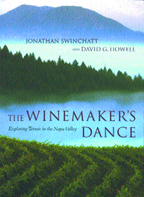
|
The Winemaker’s Dance,
by Jonathan Swinchatt and David G. Howell. University of California Press,
2004. ISBN 0 5202 3513 4. Hardcover, $34.95.
In this beautifully illustrated tale of the interplay between geology
and wine, geologists Jonathan Swinchatt and David Howell hop from winery
to winery in Napa Valley, adroitly explaining why California’s complex
geologic environment makes each vineyard the perfect place to grow a particular
wine grape. Unlike other books on “terroir” — that certain
“je ne sais quoi” blend of climate, soil, geology and culture
that influences the character and quality of wine — The Winemaker’s
Dance is also an interesting story, punctuated by scientific facts.
For that wine or geology connoisseur, this well-written book would make
an excellent gift.
|
Beasts of Eden, by David
Rains Wallace. University of California Press, 2004. ISBN 0 5202 3731 5.
Hardcover, $24.95.
Intrigued by the Yale Peabody Museum’s giant Age of Mammals mural since
the age of 10, naturalist and author David Rains Wallace has brought the
mural to life in a new book about the history of mammal evolution. Probably
fittingly, Wallace starts his exploration with the wooly mammoth (pictured
in the last frame of the mural, and perhaps the best-known of ancient mammals),
and then works his way backward through some familiar characters, such as
camels and bison, and some less familiar and odd looking creatures. As interesting
as the paleontological descriptions is Wallace’s discussion of the people
involved in mammalian studies over the years, intertwining the science with
personal and professional disagreements among major players in the field.
Not a light book, it is interesting in its outlook: using art to describe
a scientific endeavor. |
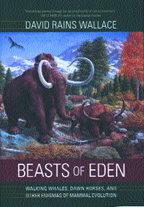 |
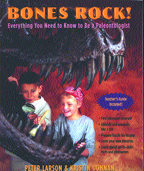
|
Bones Rock! Everything You
Need to Know to Be a Paleontologist, by Peter Larson and Kristin Donnan.
Invisible Cities Press, 2004. ISBN 1 9312 2935 x. Paperback, $19.95.
Curious kids can learn about how to find, dig up and identify bones with
this exciting guide to becoming a dinosaur paleontologist. Even parents
and teachers will appreciate Bones Rock!, which details how science
works and how some kids have changed the face of paleontology with actual
discoveries. Written by paleontologist Peter Larson and journalist Kristin
Donnan, the book includes a teacher’s guide, a companion Web site and various
Web links to rock clubs and dig programs nationwide, and is a must-have
for all aspiring paleontologists. |
Creation of the Teton Landscape:
A Geologic Chronicle of Jackson Hole and the Teton Range, by J. David
Love, John C. Reed Jr., and Kenneth L. Pierce. Grand Teton Natural History
Association, 2003. ISBN 0 9318 9557 x. Paperback, $16.95.
As the geologist authors state in this updated version of Creation of
the Teton Landscape, anyone who has visited the majestic Tetons mountain
range in Wyoming has a new (or renewed) appreciation for the power of Earth’s
forces. The authors take a comprehensive look at the geologic landscape
and history of the Grand Tetons and Jackson Hole, and break down the science
to provide a good source for anyone studying this region. Filled with stunning
pictures and interesting graphics, this makes a good coffee table book for
geologists and Western enthusiasts alike. |
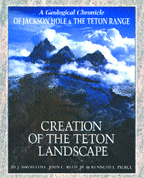 |
Book review
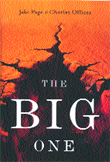 |
The Big One — The Earthquake
That Rocked Early America and Helped Create a Science
by Jake Page and Charles Officer. Houghton
Mifflin, 2004. ISBN 0 6183 4150 1. Hardcover, $24.00.
|
Quakes, Shakes and Fakes
Charles A. Langston
The iconography of earthquakes is a real problem for earthquake scientists.
Let’s face it: Earthquakes get a deserved bum rap, especially the big ones,
because they are scary and can cause destruction and death. But from the perspective
of a practicing seismologist, earthquakes are a fascinating phenomenon, a mysterious
result of largely unknown fracture physics that gives rise to majestic trains
of seismic waves traveling thousands of kilometers per hour, illuminating Earth’s
interior for scientific view.
The metaphorical icon of Jake Page and Charles Officer’s new book, The
Big One, is the standard historical and emotional one: brokenness and disaster.
The cover displays a large gaping crack in the ground waiting to swallow the
unwary reader, and the title graphic on the book’s spine is cracked by
a fault.
The book begins by describing the experiences of the 1811-1812 New Madrid earthquakes,
with Page and Officer making the point that the three large events of this incredible
earthquake sequence produced almost unbelievable ground failure in a huge area
around the earthquakes, and that the temblors were widely felt throughout the
United States. The authors give us a particularly nice touch by placing the
New Madrid earthquakes squarely into the historic timeline through accounts
of other important events, such as the great comet of 1811 and the War of 1812.
The greatest strength of the book is that it tells the stories of people rather
than of science: people who experienced the earthquakes, people who observed
(and even foretold) the events and people who developed the science of geology,
geophysics and tectonics. These stories entertainingly come up to the present
in both the development of scientific ideas and the recounting of two particular
episodes of earthquake “prediction”: the Brady-Spence prediction for
the west coast of South America in the late 1970s and Iben Browning’s prediction
in the New Madrid seismic zone in 1990.
Frankly, much of the entertainment value was simply because I personally know
many of the modern scientists mentioned in the book. Don Anderson, for example,
now a retired geophysicist from the seismology lab at Caltech, is described
as “the renegade Anderson” for his views that mantle plumes do not
exist. Arch Johnston and Buddy Schweig, my colleagues here at the University
of Memphis, are the source of much of the scientific material on the New Madrid
earthquakes, and play foils to some of the more speculative theories that Page
and Officer came up with in trying to explain the New Madrid events. It is an
even smaller world when Page and Officer talk about the characters in the Browning
prediction saga. My wife was hired by the University of North Carolina because
a seismology position opened after David Stewart, who figured prominently in
the Browning affair, was denied tenure there, mainly for his use of a psychic
for predicting earthquakes.
Some of the book’s entertainment also comes from inadvertent gaffes. For
example, Sue Hough, a well-known scientist at the Pasadena office of the U.S.
Geological Survey (USGS), was described as the 2002 “president of the American
Seismological Society.” There is no “American Seismological Society”
nor was she ever president of the Seismological Society of America.
The book also has some problematic descriptions and scientific confusions. For
example, the authors describe observations of low frequency electromagnetic
waves as a precursor to the 1989 Loma Prieta earthquake but implied that they
were sound waves. They also state that “hundreds of thousands of people
worldwide die in earthquakes every year.” According to USGS statistics,
the numbers are an order of magnitude lower at about 11,000 per year on the
average (between 1990 and 1999).
The authors do a great job in bringing the earthquake events of 1811-1812 into
the geophysical mainstream and public consciousness while pointing out the real
scientific mystery. The ways we think earthquakes are generated at plate margins
seem to have no bearing on the causes of midplate earthquakes. The subtitle
of the book, however, implies that the New Madrid events have had an important
influence on the development of seismology and tectonics. And the sections on
the history of seismology, seismological instrumentation and plate tectonics,
while a great historical perspective, clearly demonstrate that the New Madrid
events had very little to do with the development of these sciences. On the
other hand, the authors make a good case that engineer and surveyor Jared Brooks
of Louisville, Ky., may have been the first to quantitatively detect and classify
earthquakes with his measurements of nearly 1,900 New Madrid aftershocks.
I would recommend this book to my graduate students, to anyone who wants an
overview of the events of New Madrid or to anyone who wants an overview of the
field of seismology. Despite some technical flaws and some distracting speculations,
the book was a good read and very entertaining. Now if someone would just work
on another view of the earthquake as a thing of natural beauty rather than disaster
— but what do I know? I’m just a seismologist.
Langston is a professor of
seismology at the Center for Earthquake Research and Information, University of
Memphis. He has spent his career quantifying earthquakes and understanding seismic
wave propagation throughout the crust and mantle. Email: clangstn@memphis.edu.
Back to top
Mapping
New Maps from the U.S.
Geological Survey
MF-2327-D. NEVADA. Geologic insights and suggestions on mineral potential
based on analyses of geophysical data of the southern Toquima Range, Nye County,
Nevada, by D.R. Shaw, R.P. Kucks, and T.G. Hildenbrand. 2004. Scale 1:48,000.
One color sheet 71 X 40 inches with 14-page text. Avaliable for $20.00 from
USGS Information Services or free at pubs.usgs.gov/mf/2004/2327/D/.
MF-2413. ALASKA. Geologic and fossil locality maps of the west-central part of the
Howard Pass quadrangle and part of the adjacent Misheguk Mountain quadrangle,
western Brooks Range, Alaska, by J.H. Dover, I.L. Tailleur, and J.A. Dumoulin.
2004. Scale 1:100,000. Two black and white sheets with 76-page text. Sheet 1,
46 X 48 inches. Sheet 2, 46 X 29 inches. Available for $40.00 from USGS Information
Services or free at pubs.usgs.gov/mf/2004/2413/.
I-2655. UTAH and ARIZONA. Geologic map of the Kanab 30' X 60' quadrangle,
Utah and Arizona, by E.G. Sable and Richard Hereford. 2004. Scale 1:100,000.
One color sheet 57 X 42 inches. Available for $7.00 from USGS Information Services.
I-2660. WASHINGTON. Geologic map of the Mount Baker 30' X 60' quadrangle,
Washington, by R.W. Tabor, R.A. Haugerud, Wes Hildreth, and E.H. Brown.
Prepared in cooperation with the Washington Division of Geology and Earth Resources.
2003. Scale 1:100,000. Two color sheets with 74-page text. Sheet 1, 49 X 41
inches. Sheet 2, 37 X 39 inches. Available free at pubs.usgs.gov/imap/i2660/.
I-2683. OREGON. Geologic map of the Bend 30' X 60' quadrangle, central Oregon,
by D.R. Sherrod, E.M. Taylor, M.L. Ferns, W.E. Scott, R.M. Conrey, and G.A.
Smith. 2004. Scale 1:100,000. Two color sheets with 48-page text. Sheet 1, 51
X 41 inches. Sheet 2, 39 X 32 inches. Available for $14.00 from USGS Information.
I-2759. HAWAII. Geologic map of the summit region of Kilauea Volcano, Hawaii,
by C.A. Neal and J.P. Lockwood. 2003. Scale 1:24,000. One color sheet 49 X 37
inches with 14-page text. Available for $7.00 from USGS Information Services
or free at pubs.usgs.gov/imap/i2759/.
I-2771. ARIZONA. Map showing Quaternary geology and geomorphology of the
Lonely Dell Reach of the Paria River, Lees Ferry, Arizona, by Richard Hereford.
2003. Scale 1:5,000. One color sheet 51 X 39 inches with accompanying 21-page
pamphlet of comparative landscape photographs of the Lonely Dell area and the
mouth of the Paria River. Available for $7.00 from USGS Information Services.
I-2775. MISSOURI. Geologic map of the Fremont quadrangle, Shannon, Carter,
and Oregon Counties, Missouri, by R.C. Orndorff. 2003. Scale 1:24,000. One
color sheet 45 X 33 inches. Available for $7.00 from USGS Information Services.
SIM-2816. MONTANA, WYOMING, and IDAHO. Geologic map of the Hebgen Lake quadrangle,
Beaverhead, Madison, and Gallatin Counties, Montana, Park and Teton Counties,
Wyoming, and Clark and Fremont Counties, Idaho, by J.M. O'Neill and R.L. Christiansen.
2004. Scale 1:100,000. One color sheet 58 X 32 inches. Available for $7.00 from
USGS Information Services.
SIM-2826. WASHINGTON. Geologic map of the Ariel quadrangle, Clark and Cowlitz
Counties, Washington, by R.C. Evarts. 2004. Scale 1:24,000. One color sheet
60 X 36 inches with 35-page text. Available for $20.00 from USGS Information
Services or free at pubs.usgs.gov/sim/2004/2826/.
SIM-2827. WASHINGTON. Geologic map of the Woodland quadrangle, Clark and
Cowlitz Counties, Washington, by R.C. Evarts. 2004. Scale 1:24,000. One
color sheet 48 X 36 inches with 38-page text. Available for $20.00 from USGS
Information Services or free at pubs.usgs.gov/sim/2004/2827/.
SIM-2834. OREGON and WASHINGTON. Geologic map of the Saint Helens quadrangle,
Columbia County, Oregon, and Clark and Cowlitz Counties, Washington, by
R.C. Evarts. 2004. Scale 1:24,000. One color sheet 34 X 44 inches with 23-page
text. Available for $20.00 from USGS Information Services or free at pubs.usgs.gov/sim/2004/2834/.
SIM-2835. WYOMING and COLORADO. Geologic map of the Peach Orchard Flat quadrangle,
Carbon County Wyoming, and descriptions of new stratigraphic units in the Upper
Cretaceous Lance Formation and Paleocene Fort Union Formation, eastern Greater
Green River Basin, Wyoming-Colorado, by J.G. Honey and R.D. Hettinger. 2004.
Scale 1:24,000. Two sheets with 9-page text. Sheet 1, color 45 X 37 inches.
Sheet 2, black and white 35 X 43 inches. Available for $40.00 from USGS Information
Services or free at pubs.usgs.gov/sim/2004/2835/.
SIM-2836. TENNESSEE. Surficial geologic map of the Ellendale quadrangle,
Shelby County, Tennessee, by Roy Van Arsdale. 2004. Scale 1:24,000. One
color sheet 29 X 35 inches. Available for $20.00 from USGS Information Services
or free at pubs.usgs.gov/sim/2004/2836/.
SIM-2837. TENNESSEE. Surficial geologic map of the Germantown quadrangle,
Shelby County, Tennessee, by Roy Van Arsdale. 2004. Scale 1:24,000. One
color sheet 33 X 35 inches. Available for $20.00 from USGS Information Services
or free at pubs.usgs.gov/sim/2004/2837/.
SIM-2838. TENNESSEE and ARKANSAS. Surficial geologic map of the northwest
Memphis quadrangle, Shelby County, Tennessee and Crittenden County, Arkansas,
by Jason Broughton and Roy Van Arsdale. 2004. Scale 1:24,000. One color sheet
29 X 34 inches. Available for $20.00 from USGS Information Services or free
at pubs.usgs.gov/sim/2004/2838/.
SIM-2839. TENNESSEE. Surficial geologic map of the northeast Memphis quadrangle,
Shelby County, Tennessee, by Randy Cox. 2004. Scale 1:24,000. One color
sheet 33 X 34 inches. Available for $20.00 from USGS Information Services or
free at pubs.usgs.gov/sim/2004/2839/.
SIM-2847. ARKANSAS. Geologic map of the Hasty quadrangle, Boone and Newton
Counties, Arkansas, by M.R. Hudson and K.E. Murray. 2004. Scale 1:24,000.
One color sheet 44 X 33.5 inches. Available for $20.00 from USGS Information
Services or free at pubs.usgs.gov/sim/2004/2847/.
To
order USGS maps: Contact USGS Information Services, P.O. Box 25286, Denver,
Colo. 80225. Phone: 888-ASK-USGS (888-275-8747). Or go online: ask.usgs.gov/maps.html
Randall Orndorff compiles the Maps section and is
the associate program coordinator for the USGS National Cooperative Geologic Mapping
Program. Email: rorndorf@usgs.gov.
Back to top
Untitled Document











